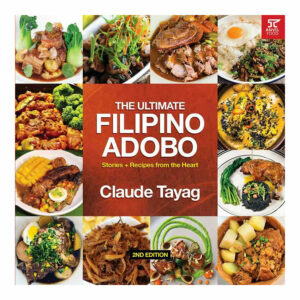THE ULTIMATE FILIPINO ADOBO by Claude Tayag might catch your eye at the bookstore by making you think that you’re about to make the ultimate adobo indeed, but you’re going to have to go through many steps to start.
It feels like an old martial arts trope, like Mr. Miyagi observing Daniel doing chores before teaching him his first kick in The Karate Kid. Before getting an actual usable recipe in the book, we have to go through several paragraphs about history, and vinegar, and even poetry. Still, adobo in theory left us as better people, and we now have a more meaningful relationship with the dish, which, as a staple, is easily taken for granted.
The first chapter includes an analysis on how the Spanish word adobo became a Filipino dish. The colonizers saw a familiar marinade; the difference being that in the Philippines, the marinade becomes the cooking liquid and sauce as well — strangely enough, daing na bangus (fried or grilled milkfish marinated in vinegar and spices), fits the bill for the Spanish definition. This chapter also includes a short study on the various vinegars of the Philippines, and how each kind imparts a different flavor to what they’re added to.
Chapter 2 sees the classics and their variations, and opens with a standard recipe, plus illustrations. It picks up the speed with explanations for the various forms and colors of adobo (white, brown, yellow, even red), and accompanying recipes. It becomes more intimate with the addition of a completely documented and photographed recipe for adobo sa palayok from the author’s family’s cook.
Mr. Tayag, well-known locally and internationally as a huge name in the Filipino food and restaurant business (an artist, he also does rounds in the art and literary industry as well), notes that there are as many recipes of adobo as there are households.
Chapter 3 includes native dishes that resembled adobo before receiving the Spanish name, while Chapter 4 sees records of adobo in print (even during the American occupation, the recipes have varied). That chapter also sees contributions by people he has met in the field, whose names might be familiar to readers. Art enthusiasts will be surprised to note that Anita Magsaysay-Ho and Benedicto “BenCab” Cabrera cherished certain adobo recipes (hers sounds Francophile and a little bit worldly; his sounds Filipino with a capital F, but with an edge). Even former news anchor Ces Drilon and beauty queen and writer Gemma Cruz Araneta join the game (her recipe, a family heirloom, gains historical significance when the book notes that she is an indirect descendant of hero Jose Rizal through his sister). Fans of restaurateurs Sau del Rosario, Myke “Tatung” Sarthou, and Jordy Navarra will be more than tickled to find out that they have shared their own adobo recipes here.
Chapter 5 features adobo recipes from Filipino chefs who have flourished abroad, but, more than that, it tells of adobo through the lens of the Filipino diaspora. How does one recreate the flavors of home when home and its familiar ingredients are far away? Hence, there are recipes by writer Jennifer Fergesen for arctic adobo made with seal and whale. There are bonuses: if you thought the names in Chapter 4 were big, wait until you read former Black Eyed Peas member Apl.de.Ap’s recipe, or even one by the present Duchess of Sussex (from back when she was Meghan Markle, the actress). Chapter 6 includes the author’s own recipes for adobo, done at his restaurants, or his various international engagements.
The book ends with a mapping of adobo’s close cousins, and a praise of pork, then rice.
The book will make an amusing gift to someone encountering Filipino culture for the first time — but Filipinos familiar to the dish and where it comes from will benefit from the book as well. In it, humble fare becomes a record of a people, a method of diplomacy, and an encouraging pat on the back. — Joseph L. Garcia
